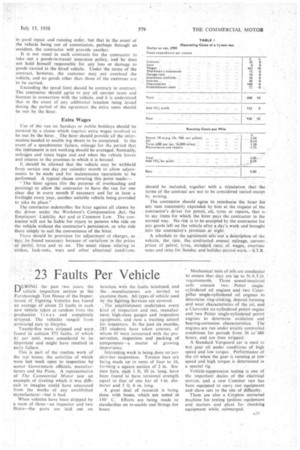23 Faults Per Vehicle
Page 73

If you've noticed an error in this article please click here to report it so we can fix it.
DURING the past two years. the vehicle inspection section at the Farnborough Test House of the Inspectorate of Fighting Vehicles has found an average of about 23 faults in each new vehicle taken at random from the production lines and completely stripped. The vehicles ranged from armoured cars to bicycles. Twenty-five were stripped and were found to contain 573 faults. of which 6.t per cent, were considered to be important and might have resulted in early failure.
This is part of the routine work of the test house, the activities of which were last week open to inspection by senior Government officials, manufacturers and the Press. A representative of The Commercial Motor saw an example of riveting which it was difficult to imagine could have emanated from the works of any established manufacturer—but it had.
When vehicles have been stripped by a team of three—an inspector and two fitters—the parts are laid out on benches, with the faults tabulated. and the . manufacturers are invited to examine them. All types of vehicle used by the fighting Services are covered.
. The establishment undertakes every kind of inspection and test, manufactures high-class gauges and inspection equipment, and runs a training school for inspectors. In the past six months, 283 students have taken courses, of whom 45 were concerned with the preservation, inspection and packing of components—a matter of growing importance. '
Interesting work is being done on torsion-bar suspension. Torsion bars are being made up in nests of four to 16, forming a square section of 2 in. Sixteen bars, each 1 ft. 10 in. long, have been found to have torsional strength equal to that of one bar of I-in, diameter and 5 ft. 6 in. long.
A great deal of research is being done with hoses, which are tested at 150' C. Efforts are being made to standardize on re-usable end fittings for hoses Mechanical tests of oils are conducted to ensure that they are up to N.A.T.O. requirements. Three sound-insulated cells contain two Petter singlecylindered oil engines and two Caterpillar single-cylindered oil engines to determine ring-sticking, deposit forming and wear characteristics of the oil, and a Chevrolet six-cylindcred petrol engine and two Petter single-cylindered petrol engines to determine oxidation and bearing-corrosion characteristics. The engines are run under strictly controlled conditions for periods from 36 to 480 hours, and are then stripped.
A Standard Vanguard car is used to test gear oil under conditions of high speed and low torque. Performance of the oil when the gear is running at low speed and high torque is determined in a special rig.
Vehicle-suppression testing is one of the important duties of the electrical section. and a new Commer van has been equipped to carry test equipment and slave sets to the site of difficulty.
There are also a Crypton universal machine for testing ignition equipment and starters and plant for checking equipment while submerged.












































































































